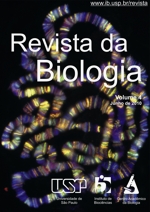Mecanismos de expressão gênica em Eucariotos.
DOI:
https://doi.org/10.11606/issn.1984-5154.v4p1-5Palavras-chave:
Controle de expressão, regulação gênica, adaptação fisiológicaResumo
Com raras exceções, as células de eucariotos pluricelulares apresentam o mesmo material genético. Porém, com o decorrer das fases de desenvolvimento do organismo ou em diferentes tecidos, as exigências metabólicas são diferenciadas, e diferentes genes são ligados e desligados, expressando um conjunto distinto de proteínas. Existem vários mecanismos responsáveis por controlar a ativação e desativação de genes (controle da expressão gênica), em diferentes momentos da vida celular. Apresentamos nesta revisão alguns passos que são passíveis de controle, bem como uma breve descrição e exemplos ilustrativos de mecanismos de regulação de expressão gênica.
Downloads
Referências
Abril J.F., Castelo R. e Guigó R. (2005). Comparison of splice sites in mammals and chicken. Genome Research. 15, 111-119.
Alberts, B., Johnson, A., Lewis, J., Raff, M., Roberts, K. e Walter, P. Molecular Biology of the Cell. 4ed., Nova Iorque, Garland Sciences, 2004.
Baler R., Covington S. e Klein D.C. (1999). Rat arylalkylamine N-acetyltransferase gene: upstream and intronic components of a bipartite promoter. Biology of the Cell / Under the Auspices of the European Cell Biology Organization. 91, 699-705.
Carginale V., Trinchella F., Capasso C., Scudiero R. e Parisi E. (2004). Gene amplification and cold adaptation of pepsin in Antarctic fish. A possible strategy for food digestion at low temperature. Gene. 336, 195-205.
Claycomb J.M., Benasutti M., Bosco G., Fenger D.D. e Orr-Weaver T.L. (2004). Gene amplification as a developmental strategy: isolation of two developmental amplicons in Drosophila. Developmental Cell. 6, 145-155.
de Andrade Stempliuk V. e Floeter-Winter L.M. (2002). Functional domains of the rDNA promoter display a differential recognition in Leishmania. International Journal for Parasitology. 32, 437-447.
Elias, M.C., Marques-Porto, R., Freymüller, E. e Schenkman, S. (2001). Transcription rate modulation through the Trypanosoma cruzi life cycle occurs in parallel with changes in nuclear organization. Molecular Biochemistry Parasitology., 112, 79-90.
Fjose A., Ellingsen S., Wargelius A. e Seo H.C. (2001). RNA interference: mechanisms and applications. Biotechnology Annual Review. 7, 31-57.
Helfman D.M., Ricci W.M. e Finn L.A. (1988). Alternative splicing of tropomyosin pre-mRNAs in vitro and in vivo. Genes & Development. 2, 1627-1638.
Kadonaga J.T. (2004). Regulation of RNA polymerase II transcription by sequence-specific DNA binding factors. Cell. 116, 247-257.
Lewin B.. Genes VII. Oxford University (Ed.)., 2000.
Maniatis T. e Reed R. (2002). An extensive network of coupling among gene expression machines. Nature. 416, 499-506.
Mayer M.G. e Floeter-Winter L.M. (2005). Pre-mRNA trans-splicing: from kinetoplastids to mammals, an easy language for life diversity. Memorias do Instituto Oswaldo Cruz. 100, 501-513.
Minn A.H., Kayton M., Lorang D., Hoffmann S.C., Harlan D.M., Libutti S.K. e Shalev A. (2004). Insulinomas and expression of an insulin splice variant. Lancet. 363, 363-367.
Neumann M., Sampathu D.M., Kwong L.K., Truax A.C., Micsenyi M.C., Chou T.T., Bruce J., Schuck T., Grossman M., Clark C.M., McCluskey L.F., Miller B.L., Masliah E., Mackenzie I.R., Feldman H., Feiden W., Kretzschmar H.A., Trojanowski J.Q. e Lee V.M. (2006). Ubiquitinated TDP-43 in frontotemporal lobar degeneration and amyotrophic lateral sclerosis. Science. 314, 130-133.
Philimonenko V.V., Zhao J., Iben S., Dingová H., Kyselá K., Kahle M., Zentgraf H., Hofmann W.A., de Lanerolle P., Hozák P. e Grummt I. (2004). Nuclear actin and myosin I are required for RNA polymerase I transcription. Nature Cell Biology. 6, 1165-1172.
Sharp P.A. (2009). The centrality of RNA. Cell. 136, 577-580.
Shoji M., Chuma S., Yoshida K., Morita T. e Nakatsuji N. (2005). RNA interference during spermatogenesis in mice. Developmental Biology. 282, 524-534.
Simpson L., Thiemann O.H., Savill N.J., Alfonzo J.D. e Maslov D.A. (2000). Evolution of RNA editing in trypanosome mitochondria. Proceedings of the National Academy of Sciences of the United States of America. 97, 6986-6993.
Singer R.H. e Green M.R. (1997). Compartmentalization of eukaryotic gene expression: causes and effects. Cell. 91, 291-294.
Venter J.C., Adams M.D., Myers E.W., Li P.W., Mural R.J., Sutton G.G. e cols. (2001). The sequence of the human genome. Science. 291, 1304-1351.
Verschure P.J. (2004). Positioning the genome within the nucleus. Biology of the Cell / Under the Auspices of the European Cell Biology Organization. 96, 569-577.
Waton, J.D. E Crick, F.H.C. (1953) Molecular structure of nucleic acids. Nature. 171, 737-738.
Wilson M.R., Ross D.A., Miller N.W., Clem L.W., Middleton D.L. e Warr G.W. (1995). Alternate pre-mRNA processing pathways in the production of membrane IgM heavy chains in holostean fish. Developmental and Comparative Immunology. 19, 165-177.
Zorio D.A.R. e Bentley D.L. (2004). The link between mRNA processing and transcription: communication works both ways. Experimental Cell Research. 296, 91-97.
Downloads
Publicado
Edição
Seção
Licença
Copyright (c) 2010 Emerson A. Castilho Martins, Paulo Roberto Maciel Filho

Este trabalho está licenciado sob uma licença Creative Commons Attribution 4.0 International License.
Salientamos que nossa revista não detém copyright, estes são exclusivos do autor do texto. Pretendemos com isso não criar entraves ao acesso do material publicado e atingir com mais intensidade nosso objetivo de divulgação da ciência.








 revistadabiologia@ib.usp.br
revistadabiologia@ib.usp.br 2008 - 2024 Revista da Biologia
2008 - 2024 Revista da Biologia